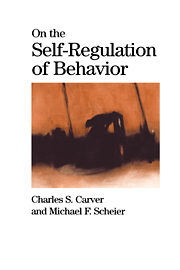Book contents
- Frontmatter
- Contents
- Preface
- Acknowledgments
- 1 Introduction and Plan
- 2 Principles of Feedback Control
- 3 Discrepancy-Reducing Feedback Processes in Behavior
- 4 Discrepancy-Enlarging Loops, and Three Further Issues
- 5 Goals and Behavior
- 6 Goals, Hierarchicality, and Behavior: Further Issues
- 7 Public and Private Aspects of the Self
- 8 Control Processes and Affect
- 9 Affect: Issues and Comparisons
- 10 Expectancies and Disengagement
- 11 Disengagement: Issues and Comparisons
- 12 Applications to Problems in Living
- 13 Hierarchicality and Problems in Living
- 14 Chaos and Dynamic Systems
- 15 Catastrophe Theory
- 16 Further Applications to Problems in Living
- 17 Is Behavior Controlled or Does It Emerge?
- 18 Goal Engagement, Life, and Death
- References
- Name Index
- Subject Index
13 - Hierarchicality and Problems in Living
Published online by Cambridge University Press: 05 June 2012
- Frontmatter
- Contents
- Preface
- Acknowledgments
- 1 Introduction and Plan
- 2 Principles of Feedback Control
- 3 Discrepancy-Reducing Feedback Processes in Behavior
- 4 Discrepancy-Enlarging Loops, and Three Further Issues
- 5 Goals and Behavior
- 6 Goals, Hierarchicality, and Behavior: Further Issues
- 7 Public and Private Aspects of the Self
- 8 Control Processes and Affect
- 9 Affect: Issues and Comparisons
- 10 Expectancies and Disengagement
- 11 Disengagement: Issues and Comparisons
- 12 Applications to Problems in Living
- 13 Hierarchicality and Problems in Living
- 14 Chaos and Dynamic Systems
- 15 Catastrophe Theory
- 16 Further Applications to Problems in Living
- 17 Is Behavior Controlled or Does It Emerge?
- 18 Goal Engagement, Life, and Death
- References
- Name Index
- Subject Index
Summary
The secret of juggling is inner harmony and knowing how to let go.
(Robert Fulghum, From Beginning to End: The Rituals of Our Lives)The last chapter described several potential contributors to people's problems which seem to be implied by the self-regulatory model presented earlier in the book. The issues we addressed there were relatively straightforward. In this chapter we continue to consider problems, but we turn to issues that are more complex. In one fashion or another, these issues all relate to the notion of hierarchicality.
LINKS BETWEEN CONCRETE GOALS AND THE CORE VALUES OF THE SELF
Several potential problems stem directly from the idea that there are hierarchical links between action goals and the core principles and values that make up the self.
Hierarchicality as an Impediment to Disengagement
One of these problems concerns the expression of the disengagement impulse. In Chapter 12 we described difficulties in which doubt causes a person to experience an impulse to disengage from some goal but the person can't do so. We managed to avoid saying much there about why people are sometimes unable to give up. The test-anxious person remains committed to passing the exam, the socially anxious person remains committed to making a good impression, the mourning spouse remains committed to the lost relationship. Why can it be so hard to give up?
Information
- Type
- Chapter
- Information
- On the Self-Regulation of Behavior , pp. 234 - 249Publisher: Cambridge University PressPrint publication year: 1998
